How to Format a Business Letter
Communicating these days is about sending an email, typing out a text message or connecting through social media. Composing an actual written business letter, and making sure it’s in a professional letter format, can seem antiquated, and yet it remains more vital than ever for small business owners.
Whether you need to write a cover letter to persuade someone to read a report, introduce yourself to a potential customer or express thanks, a well-crafted business letter can stand out. Written letters remain an important—and perhaps even crucial—part of every small business owner’s communications strategy.
Various studies have suggested that paper-based communications may be more memorable and enriching than those shown on screens, such as email. As American office workers get an average of 121 emails per day, a letter is also likely to stand out when it’s delivered via your mailbox rather than your inbox. (Some experts, including business etiquette expert Jacqueline Whitmore, also contend that handwritten letters for business purposes are even more impactful than typed letters.)

An actual business letter shows commitment because the author cared enough about the matter at hand to sit down and put ink to paper. Letters demonstrate a level of professionalism and class. They also provide a written record of what has transpired that both parties can file away. Sometimes, the events that letters mark are momentous enough for a company that they become treasured mementos.
While business letters still matter, they can damage your professional reputation if they are full of spelling and grammatical errors. You’ll also want to consider how to format a letter. A formal business letter that isn’t properly formatted can also suggest that the writer is inexperienced, unprofessional or not detail-oriented — all first (or second) impressions that business owners don’t want to make.
It is important, then, for every small business owner to know how to construct and format a professional-looking business letter properly. The types of business letter formats can include:
- Cover letters
- Thank you letters
- Complaint letters
- Adjustment letters
What Are the 12 Types of Business Letter Formats?
The most common types of business letters include:
- Cover letters. Sent with a package, report or other item, the purpose of a cover letter is to describe what is enclosed and provide a description of what the receiver should do with it.
- Thank you letters. These can be great for networking and relationship building. Don’t just write a, “Thanks for,” and leave it at that. Provide more details about what they did and how it helped you, and then close with a second expression of thankfulness.
- Complaint letters. The key to these types of letters is to demonstrate that you are displeased without being over-the-top angry. Suggest how the receiver of the letter might correct the situation.
- Adjustment letters. This is a response to a complaint letter. The point is to be humble in the response and to offer potential solutions. You want to avoid burning bridges and instead use your response as a relationship-building tool.
- Bad news letters. The key with bad news letters is to soften the blow. Being direct is valued in business writing. But when writing bad news letters, it’s best to remind the receiver about what actually works in your business relationship before breaking the bad news to him or her.
- Acknowledgment letters. They are meant to acknowledge that you received an item from someone, or that you are aware of a fact or error they pointed out. Let the receiver know when you received the package or information, and then thank them for it.
- Memos. Often used to spread important news and directives inside a company, the point with memos is to be fast and to the point with your communications.
- Congratulatory letters. The idea with these types of letters is to stay on point and avoid sounding over-the-top or mocking. Describe what motivated you to send a congratulations and the positive feedback that you have already heard. Keep the letter concise.
- Response letters. This is about explaining or listing off how a request was fulfilled.
- Letter of request. The key with these types of letters is to ask for help without groveling or being overly emotional. Take a hard look at the adjectives you’re using in the letter.
- Sales letters. These letters require a strong call to action or hook at the beginning so that the receiver continues to read and discovers the benefits of whatever you are selling. Make sure to provide information so that they can easily respond.
- Resignation letters. This is about giving notice that you are leaving a position, providing a last day of employment, and explaining what is causing you to leave.
Here are the basics you need to know when it comes to writing a business letter:
What Are the 7 Parts of a Business Letter?
While there are different business letter styles, most experts agree that a business letter should have at least seven parts. Check out the business letter example below:
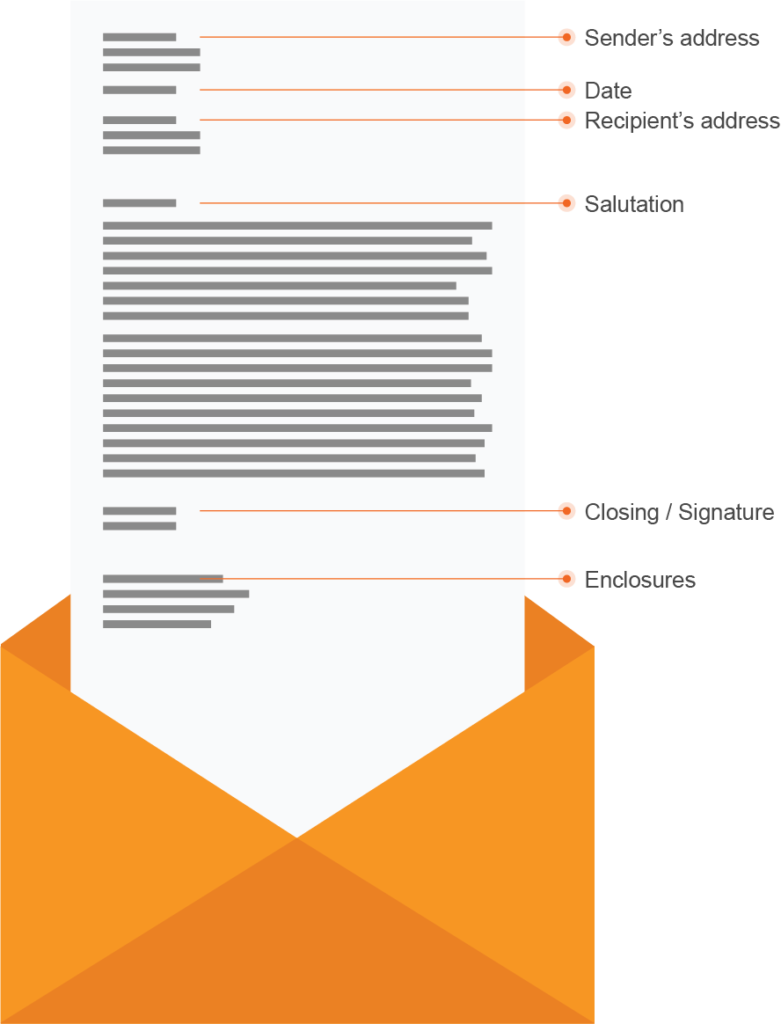
Sender’s address.
You don’t want the recipient to have to look up your address in order to write a response. A phone number and email address can be included in the sender address as well.
Date.
It should be immediately apparent when the letter was written. That way, the recipient can more easily be reminded of when and why the letter was written especially if it revolved around a particular event or business situation.
Recipient’s address.
You don’t want your assistant to have to look up the address to send the letter (or you don’t want to have to look up the address again yourself).
Salutation.
A “To whom it may concern” is a surefire way to get your letter lining a wastepaper basket. It’s important to have a name in the recipient’s address and salutation, even if you have to call up the company or do some searching on LinkedIn to find out who the letter should go to.
Body.
It’s generally wise to stay professional and get to the point. As with any communications, being clear and concise tends to reflect best on the writer.
Closing/signature.
The signature gives a personal touch to the letter, shows exactly who it’s from and that you approve the contents of the letter.
Enclosures.
It’s important to have a list of any additional items enclosed with the business letter, in case the recipient misplaces them.
Business Letter Formatting
A formal business communication can be the first impression that perspective clients, employees and other stakeholders have of you, so it’s important to make sure it’s a good one. Having the right formatting in a business letter will display your professionalism and your respect for the recipient. So, how do you format a letter for business? Follow the recommendations below.
Spacing and Font Formats
Proper business letter line spacing and presentation are important when it comes to conveying professionalism in a business letter. So, what’s the proper form for a business letter? The rule of thumb here is that utility and readability trump individuality. You’re not sending a letter to an old college friend—you’re doing business. What is the correct spacing for a business letter? Here are the spacing and font rules that one generally sees in a business letter:

Alignment. All proper business letter styles are left-aligned. The common wisdom over the decades is that such alignment is best for readability.

Spacing. Letters should be single-spaced between sentences in order to maximize space on the page. Include four line breaks between the letter’s closing sentence or paragraph and your printed name to leave space for your signature.

Font. The standard font style is Times New Roman, size 12, though other commonly used fonts such as Arial and Helvetica are acceptable. Readability is crucial when it comes to fonts, so avoid getting creative and using hard-to-read gothic or cursive fonts. If your letter’s body is running out of space on a single page, it’s better to cut it down than reduce font size.

Margins. What are the best margins for a business letter? Most experts agree that 1″ margins are the best because they maximize space, though you may have to make room for a letterhead if you’re using it. (Read more about letterhead below.)
Indented Form and Block Business Letter Examples
To indent or not to indent? That is the question. This is really a matter of how formal you want the letter to look. For example, you might want a block format to convey formality if you’re complaining about something, but a semi-block might communicate a nice, “formal light” look in a thank you letter, especially if it’s someone you already know.
Business Letter Format Examples
Block Formatting
If you don’t know what format to use, block format is often the best option. Block format is mostly used in industries like business and law, but it also can be great for cover letters and reference letters too. The entire letter is justified left and single spaced except for a double space between paragraphs. With a simple font like times new roman and black ink, you can’t go wrong with this classic format.
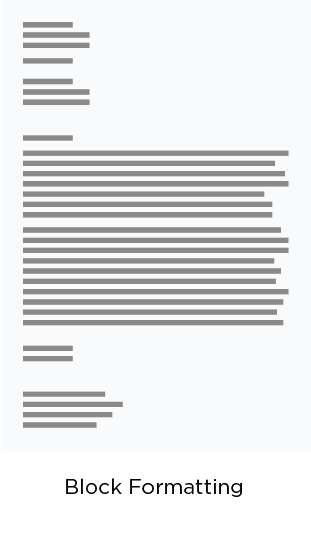
Ms. Tanya Smith, CEO
Acme Corp.
12345 Acme Ave.
Minneapolis, MN 55410
(612) 555-2368
June 1, 2018
Mr. Oscar Wilde, VP of Sales
NewTech
9876 NewTech Way
San Jose, CA 95113
Dear Mr. Wilde:
I would like a free consultation about NewTech’s cloud-based sales management software. Acme Corp. is a fast-growing manufacturer (20% annual revenue growth over the past five years). We want to continue to grow, and NewTech’s software seems like a product that might take our sales team to the next level. I want to explore with you whether NewTech software is a good fit for Acme.
I look forward to speaking with you at your earliest convenience.
Sincerely,
Tanya Smith, CEO
Enclosures: Acme Corp. brochure
Note that this is a more formal type of business letter: no indentations and everything is on the left justify. If you’re questioning how formal the letter should appear, it’s probably best to play it safe and go with a block format.
Modified Block Formatting
Modified block format is slightly different from the block format. The entire text is aligned to the left except for the date, sender’s address and closing. Modified block format is another commonly used business letter format but it’s slightly less formal than block format.
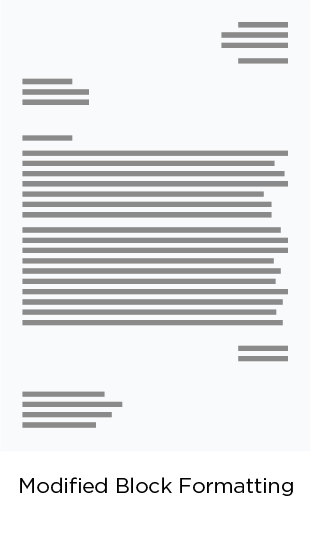
Ms. Tanya Smith, CEO
Acme Corp.
12345 Acme Ave.
Minneapolis, MN 55410
(612) 555-2368
June 1, 2018
Mr. Oscar Wilde, VP of Sales
NewTech
9876 NewTech Way
San Jose, CA 95113
Dear Mr. Wilde:
I would like a free consultation about NewTech’s cloud-based sales management software. Acme Corp. is a fast-growing manufacturer (20% annual revenue growth over the past five years). We want to continue to grow, and NewTech’s software seems like a product that might take our sales team to the next level. I want to explore with you whether NewTech software is a good fit for Acme.
I look forward to speaking with you at your earliest convenience.
Sincerely,
Tanya Smith, CEO
Enclosures: Acme Corp. brochure
Note that there are still no indentations, but everything doesn’t line up on the left. It’s just a bit less formal. Smith might be wiser to stick with the block format in this case, but she might switch to modified block once she has a working relationship with Wilde.
Semi-block Formatting
Semi-block format is less commonly used. It’s similar to modified block format except that each paragraph is indented instead of left justified. Semi-block format is a less formal option to keep in your business letter writing toolbox.
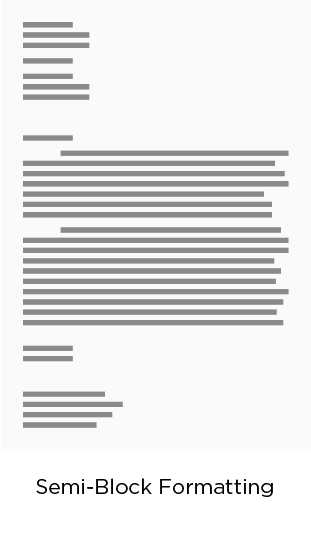
Ms. Tanya Smith, CEO
Acme Corp.
12345 Acme Ave.
Minneapolis, MN 55410
(612) 555-2368
June 1, 2018
Mr. Oscar Wilde, VP of Sales
NewTech
9876 NewTech Way
San Jose, CA 95113
Dear Mr. Wilde:
I would like a free consultation about NewTech’s cloud-based sales management software. Acme Corp. is a fast-growing manufacturer (20% annual revenue growth over the past five years). We want to continue to grow, and NewTech’s software seems like a product that might take our sales team to the next level. I want to explore with you whether NewTech software is a good fit for Acme.
I look forward to speaking with you at your earliest convenience.
Sincerely,
Tanya Smith, CEO
Enclosures: Acme Corp. brochure
Note that this is pretty much a block format, but the paragraphs have indentations. If you’re debating whether to use block or modified block format (or simply hate looking at paragraphs without indentations), semi-block is a nice compromise.
The Tone for Business Letter Formatting
Beyond the proper letter format, the tone of a formal business letter can be critical if it is to accomplish your business goals, or at least ensure that you are taken seriously. Here are some important tips when it comes to setting the appropriate tone in the letter:
- Do not come across as arrogant, or boastful.
- Make your tone conversational, yet professional.
- It’s generally a good idea to get to the point as quickly as possible. As Benjamin Franklin liked to say, “Time is money.”
- When writing complaint letters use a formal tone to express displeasure, but the tone should not be overtly angry. “We were initially excited to subscribe to your sales management software, but were disappointed to discover that…” Briefly describe the problem and then explain how you would ideally like to have it resolved.
- When writing letters that contain bad news, maintain the concise and professional tone of a business letter, but also be sensitive to the reader’s feelings. You don’t want to burn your bridges. This is one case where you do not want to quickly get to the point. You’ll want to buffer the blow: “We were glad to learn of your company’s interest in our company’s sales management software.” It’s important to be earnest and try to get the recipient to see your point of view: “We, too, are a fast-growing company, so we unfortunately do not have the resources yet to provide a free consultation to every prospective customer.” Close with goodwill, as well as a potential solution. “I’m sorry we don’t have free consultations, but we very much want to start a business relationship with you. I’m enclosing brochures about ways our software might meet your company’s needs. I’m happy to discuss more over the phone, as well as arrange a free trial of our software.”
- When writing a memo, be sure to use an extremely crisp, to the point, businesslike tone. Memos are often internal company communications, so it makes sense not to waste employees’ time with niceties. “Our newest software product brochures are set to go to the printers. Please place your orders within the next 10 days based on your anticipated needs.”
Word Choice and Grammar

Word choice can make or break the effectiveness of your business letter writing. Seek directness in your language, avoiding words such as “try,” “just,” “probably,” and “maybe.” Keep your language simple, avoiding the obscure words or jargon that people sometimes fall back on when they’re trying to sound more intelligent than they are.
Wondering if a word properly conveys the meaning you’re intending? Try dictionary and thesaurus searches online. In cases where the letter is especially important, it also helps to have someone else edit and read the letter to provide feedback.
At all costs, avoid grammatical mistakes. They suggest you lack attention to detail and professionalism.
Also, use verbs that have an active versus a passive voice. Active voice shows that you are in charge and responsible for your actions. (Example: “We will install your software by Sept. 1.” Not… “Your software will be installed by Sept. 1.”)
Signature Formats
When it comes to the signature, it’s important to avoid stamps and computerized signatures. A handwritten signature is a sign that you endorse the message of the letter. Beneath the transcribed signature, you should type your name and title to avoid confusion from your handwriting. If representing a company, the company’s name should be written in caps. Also remember to include four spaces between the complimentary closing and the typed name, in order to provide enough space for the signature.
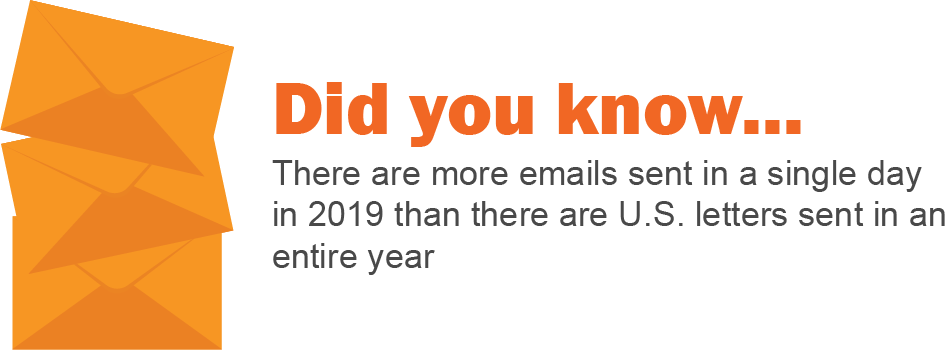
Email Business Letter Formats
A written business letter can truly make a difference because it conveys that whoever sent the letter is serious. It’s easy to quickly dash off an email to someone and press “send,” but a written letter takes time. You’ll need to truly think about what you’re writing, double-check to make sure there aren’t any silly mistakes, and then get the letter into an envelope and sent to its destination.
Sometimes, though, time is so important that you simply need to send an email. Even in that case, though, using a block format might add some formality to it.
Common Mistakes and Errors
Avoid routine mistakes in your business letter, because they suggest sloppiness. Run the text through Grammarly to double-check for:
- Grammar issues
- Typos
- Duplicated words
- Punctuation mistakes
Make sure to also do a spell check while you’re at it. Any proper names you’re using in the letter — do a Google search to double check that you’re spelling them correctly.
Letterhead Formats
You might also consider using a business letter format with letterhead for your company’s letters because it offers a professional appearance and is also informative. Having stationery with letterhead is kind of like having a company website: It indicates that your business is legit.
The letterhead should display the company’s mailing address, phone number and any other contact information. If using letterhead, you will need to remember to adjust the margins and formatting accordingly.
Writing business letters is a fundamental skill for any business owner and your professional life in general. A well-written letter shows that you mean business because you took the care and time to write, format, print and mail it. If a business gets a written complaint in the mail, odds are that the author is not going to let the matter drop. Similarly, a written thank you letter is much more powerful and effective than thanks conveyed via email.
A formal business letter, however, loses its power if its formatting is unprofessional, if it sets the wrong tone, if it’s poorly written, or if it includes grammar and spelling mistakes. So it’s important to learn how to do them right.
As a small business owner, you’re an expert, too. We want to hear about how you feel about business letters. Let us—and your fellow SBOs—know by sharing a comment below.
Next steps: Want more small business tips as you work toward your entrepreneurial goals? Sign up for the Small Biz Ahead newsletter today.






I’m very interested
That’s great to hear, Jason! You can learn more about business letters by also reading through these SBA articles:
https://sba.thehartford.com/business-management/business-questions/writing-business-letters/
https://sba.thehartford.com/business-management/marketing/parts-of-a-business-letter/
This site was very useful to me.
That’s great to hear! Thank you for the positive feedback.
Amazing.
Indeed, this is helpful and has opened a lot to me.
That’s great to hear, Joseph!
I wanted to say that these articles have really helped me in my letter writings. Thank you for sharing your knowledge.
That’s great to hear! We’re happy to help. Thanks for reading SBA!
Please contact to me I want learn how to write official letter.
Thanks for reaching out! You can learn more about writing a business letter by reading this article: https://sba.thehartford.com/business-management/business-questions/writing-business-letters/
Thank you it helps me a lot.
You’re welcome!
Thanks for sharing this information.
Loved the blog!
You’re welcome, Sam! We’re so glad you liked it.
Thank you for the informative article.
That’s great to hear, Sean! We’re glad you found it informative. Here’s another SBA article on business letters you can check out too:
https://sba.thehartford.com/business-management/marketing/parts-of-a-business-letter/
Thanks for reading SBA!
Thank you so much.
You’re welcome, Jeanette!
Thanks! Huge help.
You’re welcome!
I loved seeing this info and learned a lot of new things from your article, can you write more about it?
We’re glad you liked it! Here are some more of our articles that you might find interesting as well:
https://sba.thehartford.com/business-management/business-questions/writing-business-letters/
https://sba.thehartford.com/business-management/marketing/business-letter-enclosure-notation/
https://sba.thehartford.com/business-management/marketing/memo-format/
https://sba.thehartford.com/business-management/business-communication-mistakes/
Thanks! Great help.
You’re welcome! We’re glad it helped!
This article is really enhancing my letter-writing skill.
Thanks a lot Kelly Spors.
I would like to know the sources of your writing and suggested the recent letter writing books with authors names.
Thanks for accurate tips. Helped a lot.
Glad we were able to help, Noreen!
This article helped me a great deal in letting my students how important it is to be professional in writing business letters. As they say, what you are is what you write.
Thank you very much. Keep on pushing and posting items like this.
So glad you found the article valuable!